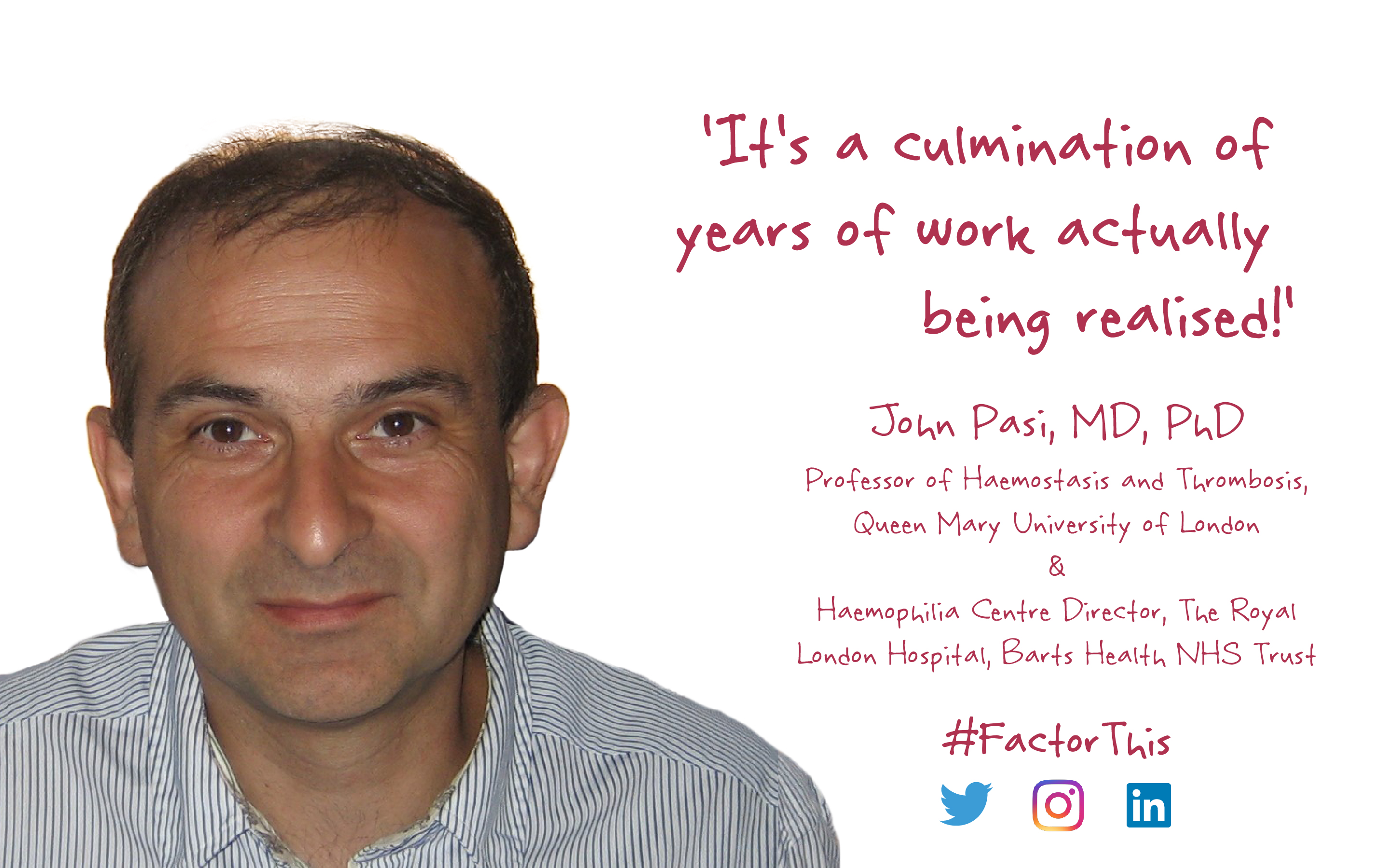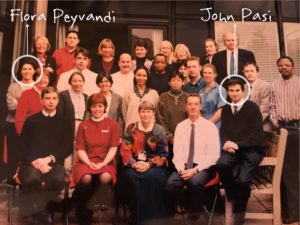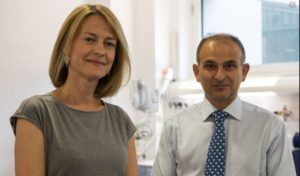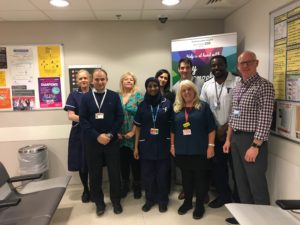
The working year is nearly over but we’re thrilled to be rounding off our Factor This! blog series with yet another exceptional scientist and clinical thought-leader in haemophilia – Professor John Pasi.
Since 2003, John has been Professor of Haemostasis and Thrombosis and Honorary Consultant Haematologist at Barts and The London School of Medicine and Dentistry, Queen Mary University of London, UK. John is also Director of one of the world-leading haemophilia centres at The Royal London Hospital, Barts Health NHS Trust, Whitechapel, London, where he oversees the delivery of specialist comprehensive care with a multidisciplinary team of experts for people with inherited and acquired bleeding disorders.
John has a huge passion and commitment for developing and teaching about new, novel therapies and advancing innovation in haemophilia, which is emulated in his research capacities and role as a Chief Investigator for a number of the ground-breaking clinical trials we’re seeing in the community today.
When John’s not uber-busy in clinic, he is often in high-demand to speak at the most prestigious, global scientific meetings. So, we were really grateful to grab a moment with him off the back of his appearance at the 60th American Society of Hematology (ASH) Annual Meeting and Exposition in San Diego, California, USA to reflect on his work in haemophilia and his opinions on the current state of play with treatment optimisation and development…
1) Hi John! In our last feature with Flora Peyvandi we learned why she chose to specialise in haematology. Was this a conscious decision for you also?
we learned why she chose to specialise in haematology. Was this a conscious decision for you also?
![]() Actually, no. You could say it was by accident.
Actually, no. You could say it was by accident.
Originally, after graduating from medical school at the University of Birmingham in 1983 and completing my first year of training as a junior doctor, I wanted to become a surgeon but then changed my mind. Instead, I went about applying for what we used to call Senior House Officer roles,1 yet for one reason or another, I didn’t get shortlisted.
As I had done quite well as a student in pathology, my professor back then suggested to pursue this.
You had to choose two pathology specialities to follow. One I really enjoyed was chemical pathology. My second choice was histopathology, which everyone wanted to do. Because I didn’t list it as my number one option, I wasn’t successful.
In its place, I was sent to do haematology at Birmingham Children’s Hospital. Unbeknown to me, this would be the beginning of my career into haemophilia…
2) Did you have any expectations going into this?
![]() I hadn’t ever envisaged caring for children and truth be told, I went there ‘under sufferance.’ However, my perceptions were totally turned on their head by a consultant I worked with called Professor Frank Hill. He was amazingly inspirational!
I hadn’t ever envisaged caring for children and truth be told, I went there ‘under sufferance.’ However, my perceptions were totally turned on their head by a consultant I worked with called Professor Frank Hill. He was amazingly inspirational!
He gave me a huge appetite for paediatric haematology. Frank Hill’s particular interest was haemostasis and he offered me the chance to apply for a research position with him related to immunology and haemophilia, which I did.
This is where I first came across children and young boys with haemophilia.
3) What were those early experiences like for you?
![]() It was the mid-to-late 1980s and as similarly expressed by my colleagues in your other interviews, a really tough period for all involved in haemophilia care.
It was the mid-to-late 1980s and as similarly expressed by my colleagues in your other interviews, a really tough period for all involved in haemophilia care.
We had very many concerns around infections like HIV and hepatitis C in the blood supply and through the products we were using.2 The silver lining to me of this very dark time was being able to support the kids at the centre through it all.
The other point to make is, because of the improving treatment and its availability for our children, I wasn’t necessarily seeing the physical disabilities and related long-term joint complications from bleeding episodes. It wasn’t until I got my first role as a consultant in haemostasis at the Royal Free Hospital in London in 1993, that I actually started to see the bigger picture with regards to adults and how a lack of viable treatment years earlier had impacted on them.

4) How were your research interests evolving over this time?
![]() There was a feeling around then of immune problems – aside from HIV – in people with haemophilia maybe due to the plasma-derived clotting factor concentrates they were receiving. My PhD focussed on immune abnormalities in multi-treated patients with haemophilia.
There was a feeling around then of immune problems – aside from HIV – in people with haemophilia maybe due to the plasma-derived clotting factor concentrates they were receiving. My PhD focussed on immune abnormalities in multi-treated patients with haemophilia.
As part of that, I was also getting into molecular biology as we were trying to set up genetic analysis for the factor (F)VIII gene for things like antenatal diagnosis for haemophilia A. I had the two aspects of my research running side-by-side.
When I moved to the Royal Free, the immunology side was naturally drawing to a close because of what we knew already about the new treatments coming along, and how a lot of these issues were related to co-morbidities.3 And so, my focus shifted mainly to molecular biology and genetics.
We started in the early ‘90s trying to look at gene transfer for haemophilia.4 This is how I got into gene manipulation.
5) Can you tell us about some of your early gene therapy exploration in haemophilia?
![]() We did some really basic stuff back then, none of which seemed to work at all! Whatever we tried turned out to be an abject failure…
We did some really basic stuff back then, none of which seemed to work at all! Whatever we tried turned out to be an abject failure…
In the beginning, we attempted a direct gene injection approach. This was because a Professor in anatomy, Geoff Goldspink, had found you could get some gene expression literally by injecting straight into a muscle. We were trying this with small clotting factor genes like FVII but it wasn’t anywhere near efficient enough.
There was also the joint work we were doing with Dr. Katherine High![]() between 1997-1999 using adeno-associated virus (AAV)-based mechanisms with the FIX gene for haemophilia B to look at immune responses. Back then, people made lots of assumptions about taking a human gene, putting it in an animal model,5 achieving some expression but then being hampered by the development of neutralising antibodies. Looking back, it isn’t such a surprise seeing as you’re introducing a foreign human protein into animals. It was the realisation that, “Oh, actually, we should be putting mouse genes into mice and not human genes.” In retrospect these were so glaringly obvious but just weren’t done at the time.
between 1997-1999 using adeno-associated virus (AAV)-based mechanisms with the FIX gene for haemophilia B to look at immune responses. Back then, people made lots of assumptions about taking a human gene, putting it in an animal model,5 achieving some expression but then being hampered by the development of neutralising antibodies. Looking back, it isn’t such a surprise seeing as you’re introducing a foreign human protein into animals. It was the realisation that, “Oh, actually, we should be putting mouse genes into mice and not human genes.” In retrospect these were so glaringly obvious but just weren’t done at the time.
Overall, we found some animal models were more tolerant to the gene therapy than others, some gene structures proved more problematic, and so on…
A few years later, other scientists like Professor Ted Tuddenham and Professor Amit Nathwani started to pick up on the use of AAV-vectors and this line of investigation.6 They’re the real guys who pushed through this method and ultimately shaped where we are today.
6) Fast forward nearly two decades, gene therapy for haemophilia was global news and you were lauding the latest clinical trial results as ‘mind-blowing’. How do you reflect on this?
![]() It was huge, really!
It was huge, really!
All of sudden, we had both haemophilia A and B that could be successfully addressed for the first time by gene therapy with really positive results. This was a culmination of years and years of work actually being realised in publication in the New England Journal of Medicine, which was a big wake-up call for lots of people to how meaningful all of this was.
With the data coming out from both sides of the Atlantic and simultaneously being presented back-to-back at the ASH meeting in 2017, I think everybody thought, “Wow! Gene therapy might really mean something now, it may actually be able to deliver.”
The response was simply amazing! People were writing to me from all over the world. It was picked up by the international press and was seen as a really good news story!

7) Do you feel there is still the same level of hype around gene therapy for haemophilia a year on?
![]() I suspect there aren’t going to be any massive leaps forward or huge media splashes again for a little while. You could say we’re in a plateau of productivity as illustrated by something called the Gartner Hype Cycle.
I suspect there aren’t going to be any massive leaps forward or huge media splashes again for a little while. You could say we’re in a plateau of productivity as illustrated by something called the Gartner Hype Cycle.
This tracks the progress of emerging technology trends. When a new concept comes along, you get hugely inflated expectations, so the graph goes shooting up. But as you discover things not working as predicted, the graph plummets to the bottom. This is the trough of disillusionment. Then, as people slowly get results and understand more about the challenges at hand, progress plateaus.
Gene therapy has been on a similar cycle: it reached the top at the start of the ‘90s, collapsed in the 2000s because everything anybody did never really delivered, but then has gradually regained its credibility. It was Prof. Nathwani and Prof. Tuddenham’s publication in 2011 that ‘relit the fire,’ so to speak, and encouraged others to push research in this area.
Right now, we’ve got a steady accumulation of really solid data, which is going to be for everybody’s benefit; understanding what we can do for people living with haemophilia, ensuring its safety and durability, and how we’re going to realistically deliver it in clinical practice.
8) How are the gene therapy clinical trials for haemophilia progressing at your centre?
![]() We’re trying to expand patient numbers for the phase 3 studies and iron out some of the questions still unanswered from the phase 1/2 data, including the variability and predictability of factor levels. But recruitment is challenging.
We’re trying to expand patient numbers for the phase 3 studies and iron out some of the questions still unanswered from the phase 1/2 data, including the variability and predictability of factor levels. But recruitment is challenging.
Gene therapy for haemophilia is a really crowded field right now. Lots of companies are competing and anybody that volunteers for a gene therapy – should it not meet expectations – cannot then be considered for another with the current technology. So, they’re taken out of the recruitment ‘pool’ as it were.
It’s a big decision for the individual and their family because it’s potentially a one-off and there are still unknowns. You have to decide if you’re happy with the trials available today, or want to wait until something more effective comes down the line, if it ever does. Things might be very different, say in 10 years time, but at this moment, you only get ‘one bite of the cherry.’
The cohort that first went through gene therapy programmes had an amazing spirit of altruism. They didn’t know if it was going to work or not but understood they were helping science. The community owes them a great debt.
9) Do you see gene therapy as the ‘be all and end all’ for haemophilia?
![]() Haemophilia’s not all about gene therapy today. It’s looking to expand opportunities. Gene therapy’s a tall poppy in the field but there are and will be other great therapies.
Haemophilia’s not all about gene therapy today. It’s looking to expand opportunities. Gene therapy’s a tall poppy in the field but there are and will be other great therapies.
We are already anticipating the next generation of bispecific antibodies7 and we still have other novel, rebalancing therapies to come like RNAi suppression,8 anti-TFPIs9 and Serpin-PC.10 These are just the ones I’m aware of. There are other technologies a bit more under wraps that we’re still yet to hear about.
We’re also moving towards the next generation of extended half-life therapies,11 either intravenous or subcutaneous, which for FVIII in particular may provide a half-life of around 35-40 hours. This means if you were to treat once a week, you could maintain a trough level – the minimum factor level measured before the next injection – of about 15%, or even see normal levels if the frequency’s doubled.
The focus should no longer be on only achieving a trough level of 1%.12 All of these products are really opening up our eyes and prospects for huge change now and in the future!

10) In terms of the UK haemophilia market, is it realistic to expect that the funding will be there to get these novel treatments into clinic?
![]() There are significant challenges and one worries about these because haemophilia care is so driven by cost in the UK.
There are significant challenges and one worries about these because haemophilia care is so driven by cost in the UK.
Since 2004 we’ve had national tenders,13 which have been phenomenally helpful at saving money and keeping treatment costs down. The upside of this is that, on the whole, we’ve been able to increase the amount of product we use. There is a but…
It’s well known that the UK haemophilia market is one of, if not, the cheapest in the world. Therefore, we have to ask how some of the pharmaceutical companies will be able compete with their new products when as a country, we’re so cheap already? In other words, will we be able to access all of this really exciting stuff?
It isn’t a question that these novel treatments are just about convenience. Moreover, they’re hopefully going to provide a level of protection over and above today’s standards. As treaters, we recognise that the 1% I mentioned has to be the minimum for people living with severe haemophilia. We have to push this higher to at least 3-5% to afford individuals the best joint health and reduce bleeding rates.
Many healthcare payers still see the 1% as adequate and we’re deemed to be profligate if running troughs any higher. I would argue that we don’t treat people living with diabetes with just enough insulin to stop them from going into diabetic coma. They’re provided enough insulin to normalise their life. Why should it be any different in haemophilia terms with current factor replacement therapy?
At the end of the day, the UK is a very cost-effective haemophilia market that still provides value. Can these other treatments match this?
11) We couldn’t possibly finish without getting your brief views on the ASH meeting over 2 weeks ago. For those of us who were unable to attend, what were some of the main talking points for haemophilia?
![]() There was extra data on gene therapy using different vectors for haemophilia A and B – all adding more critical knowledge-base to the field. Also, we heard more regarding bispecific antibodies and the exciting early clinical trial results about the next generation of FVIII EHLs that I commented on earlier – this is all really encouraging and even more promising for the community!
There was extra data on gene therapy using different vectors for haemophilia A and B – all adding more critical knowledge-base to the field. Also, we heard more regarding bispecific antibodies and the exciting early clinical trial results about the next generation of FVIII EHLs that I commented on earlier – this is all really encouraging and even more promising for the community!
I have to say, we’ve come a long way, especially over the last 8 years or so. The big new thing really then was about a new way of mixing up factor concentrates!
––– End –––
What an awesome way to see out the year – thanks so much to John for giving us lots to think about and look out for moving into 2019!
We must add how grateful we are to everybody – our wonderful interviewees, their support staff as well as all of our brilliant production support – for making our Factor This! blog series such a success!
If you have a question or comment for John, or about any of our previous features in this series, you can leave a message below or get in touch directly via our contact page (please refer to our privacy policy statement here).
You can also keep up to date with all of our activities by following us on Twitter, Instagram and LinkedIn.
On The Pulse
Disclaimer:
This site is designed to offer information for general educational purposes only. The health information furnished on this site and the interactive responses are not intended to be professional advice and are not intended to replace personal consultation with a qualified physician, pharmacist, or other healthcare professional. We cannot provide individual medical advice. You must always seek the advice of a professional for questions related to a condition, its symptoms, and appropriate therapeutic treatments.
Footnotes:
- A junior doctor entered the senior house officer (SHO) grade to begin to develop specialty specific knowledge and competencies, amongst others (Carr, 2003). The equivalent today is Foundation Year 2 after the recent changes in postgraduate medical training in the UK (Shofiq, et al., 2011).
- People with haemophilia treated with plasma-derived clotting factor concentrates before 1986 and the early introduction of virus inactivation procedures, experienced a near-100% risk of infection with the hepatitis C virus (HCV) (Darby et al., 1997). In the UK, some 4,670 people with haemophilia became infected with HCV (Archer, 2009). About a fifth of the community contracted the human immunodeficiency virus (HIV) between 1979 and 1985, with coinfection contributing to mortality in these men (Sabin et al., 2005). In July 2017, current UK Prime Minister Theresa May announced a UK-wide inquiry into contaminated blood. The Infected Blood Inquiry has now begun its investigative work and we will be reporting on this in 2019.
- For further scientific reading of the time, please refer to the following literature where John Pasi was lead author/co-author:
c) Association of changes in monocyte antigen presentation and cytokine production in haemophilic boys with treatment and blood borne virus infection (Pasi et al., 1995).
- For more than 30 years, since the clotting factor genes were cloned, “curing” haemophilia through gene transfer of factor (F)VIII and FIX genes has been anticipated (Pierce and Iorio, 2018). We’ve referred to and reported on gene therapy for haemophilia in various features over the year – please view them here.
- Animal models such as factor (F)VIII- and FIX-knockout mice and dogs with haemophilia A or B, have facilitated extensive preclinical evaluation of gene therapy strategies (Nathwani, Davidoff and Tuddenham, 2017).
- Multiple vehicles, or vectors, for haemophilia gene transfer have been investigated. In a landmark study, Nathwani and colleagues reported sustained factor (F)IX expression in individuals with severe haemophilia B following adeno-associated virus (AAV)-mediated in vivo [inside the patient’s body] FIX gene transfer (George and Fogarty, 2016). All published and currently open gene therapy studies in haemophilia use AAV vectors (Doshi and Arruda, 2018).
- In February 2018, the European Medicines Agency (EMA) granted marketing authorisation for Hemlibra® (Emicizumab; Roche/Chugai) to prevent bleeding or reduce the frequency of bleeding episodes in people living with haemophilia A with factor (F)VIII inhibitors, both children and adults. It is a humanised bispecific monoclonal antibody (Mab) that is designed to restore FVIII function by binding to two key components of the coagulation cascade, activated FIX (FIXa) and FX, to mimic the role of FVIII (Balkaransingh and Young, 2017). Hemlibra® is the first subcutaneously administered haemophilia treatment to be approved and is also the first non-factor agent for haemophilia (Brown and Green, 2018). At the time of writing, it is approved for use in people living with haemophilia without inhibitors in the US only.
- RNA interference (RNAi), a natural process for gene silencing, was discovered in 1998 (see Nature’s RNAi animation). It quickly became a powerful research tool to control protein expression. (Morrison, 2018). This modality is being exploited by researchers for haemophilia by suppressing the main naturally-occurring anticoagulant antithrombin, which acts by inactivating factor (F)Xa and the major clotting protein thrombin. The point being that, rather than replacement of the missing FVIII or IX, depletion of clot inhibitors is used to achieve haemostasis. This approach was experimentally supported by results obtained in a mouse model of haemophilia A, showing that reduction of the plasma levels of antithrombin improved thrombin generation and was associated with a less severe bleeding phenotype. (Ragni, 2015; Franchini and Mannucci, 2018). Fitusiran (Alnylam/Sanofi), an investigational RNAi therapeutic targeting antithrombin for the treatment of people living with haemophilia A and B is currently in phase II/III trials (Brown and Green, 2018).
- Tissue factor pathway inhibitor (TFPI) is one of the natural anticoagulants in the body being targeted by haemophilia researchers as a novel therapeutic agent. Several haemophilia animal studies have demonstrated that inhibition, or blocking, of TFPI can enhance haemostatic activity, leading to more stable clot formation and reduce bleeding. These promising results have prompted further studies in people living with haemophilia with and without inhibitors (Balkaransingh and Young, 2017).
- The protein C system is also an attractive potential target for inhibition. The anticoagulant enzyme known as activated protein C (APC) is one of the major natural inhibitors of the coagulation system. Several preclinical studies are ongoing and show promising results by using different molecules to prevent APC from ‘shutting down’ thrombin production, such as serpins, and their potential use as novel therapeutic strategies for haemophilia treatment. (Polderdijk et al., 2016; Balkaransingh and Young, 2017).
- New methods for extending clotting factor half-life – the duration of action of the drug in the body – to provide extended dosing intervals and increased joint protection are being explored beyond PEGylated and protein fusion formulations (albumin and Fc). These include the novel investigational recombinant factor (rF)VIII and rFIX therapies, BIVV001 and BIV002 respectively (Bioverativ/Amunix), which use XTENylation technology and are designed to circulate in plasma independently of von Willebrand factor (VWF) – FVIII clearance is principally determined by VWF – thereby breaking the VWF half-life ceiling (Brown and Green, 2018; Konkle et al., 2018).
- To date, opinion on optimising haemophilia care has centred on the idea of the need to maintain factor activity above a trough of 1% baseline factor activity level. Although not conclusive, this recommendation is supported by the finding that increased time with a factor VIII activity below 1% is associated with an increased rate of breakthrough bleeding. Only in recent years has data emerged that suggest a baseline greater than 1% might be preferable (Jiménez-Yuste et al., 2014).
- Read about the history, evolution and principle features of the UK’s national procurement scheme of clotting factor by Professor Charles Hay in his paper, Purchasing factor concentrates in the 21st century through competitive tendering (2013).

